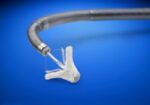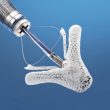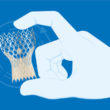We are less than a month away from the most important interventional cardiology event in Latin America. Consequently, we have started to share information on some of the most appealing sessions that you will be able to enjoy in Mexico City from August 1st to 3rd, 2018. On that vein, we are pleased to communicate<a href="https://solaci.org/en/2018/07/03/over-10-keynote-conferences-confirmed-at-solaci-socime-2018-congress/" title="Read more" >...</a>
MitraClip: Impact of Sinus Rhythm and Heart Rate
Courtesy of Dr. Carlos Fava. Atrial fibrillation (AF) and fast heart rate (>70 lpm) have been shown to increase the risk of mitral valve repair surgery. The MitraClip has shown benefits in high risk patients, but its relation to abnormal heart rhythm has not yet been established. 760 patients were analyzed; 315 (52.4%) presented<a href="https://solaci.org/en/2017/03/06/mitraclip-impact-of-sinus-rhythm-and-heart-rate/" title="Read more" >...</a>
MitraClip® in real life
Original title: Acute outcomes after MitraClip® therapy in highly aged patients: results from the German TRAnscatheter Mitral valve Interventions (TRAMI) Registry. Reference: Wolfgang Schillinger et al. EuroIntervention 2013; 8-online publish-ahead-of-print April 2013. Recently, percutaneous repair of the mitral valve with MitraClip®, (Abbott Vascular, Santa Clara, CA, USA), has emerged as an option for patients with severe mitral regurgitation,<a href="https://solaci.org/en/2013/04/17/mitraclip-in-real-life/" title="Read more" >...</a>
Evolution of Cardiac Damage in MitraClip
Degenerative mitral valve regurgitation affects the mitral apparatus and is related to severe insufficiency. At present, surgery is the treatment of choice for patients at low risk. Oftentimes, this disease affects the elderly and/or those at high surgical risk, edge-to-edge repair being an excellent treatment alternative. We all know that the different stages of ventricular<a href="https://solaci.org/en/2024/07/09/evolution-of-cardiac-damage-in-mitraclip/" title="Read more" >...</a>
Aortic Stenosis Progression Evolution
Aortic stenosis is an increasingly common valvulopathy because people are living longer now. A present, the main treatment consists of surgical (SAVR) or transcatheter aortic valve replacement. (TAVR). One of the main challenges of this disease is its progression. The European guidelines recommend Doppler echocardiograms every 2 to 3 years for mild cases, mildly calcified,<a href="https://solaci.org/en/2024/05/15/aortic-stenosis-progression-evolution/" title="Read more" >...</a>
12-Month Evolution of Edge-to-Edge Repair with PASCAL
Mitral regurgitation (MR) is the most frequent valve disease. Mitral transcatheter edge-to-edge repair (M-TEER) has been shown beneficial in high or prohibitive risk patients in cases of degenerative and functional MR. The PASCAL device has been shown safe and effective by the CLASP II, but we still need further research in clinical “real world” environments. <a href="https://solaci.org/en/2024/05/02/12-month-evolution-of-edge-to-edge-repair-with-pascal/" title="Read more" >...</a>
TAVR in the Different Types of Aortic Stenosis
Aortic stenosis (AS) is classified according to gradient into high flow and high gradient (D1), low flow-low gradient with reduced ejection fraction (D2), and paradoxical low flow-low gradient with conserved ejection fraction (D3). D3 AS is characterized by ≥50% ejection fraction, but with systolic volume index ≤35 ml/min. Post TAVR evolution of D2 and D3<a href="https://solaci.org/en/2024/04/05/tavr-in-the-different-types-of-aortic-stenosis/" title="Read more" >...</a>
Edge-to-Edge Repair in Cardiogenic Shock
The edge-to-edge approach with MitraClip has been established as a valid strategy for patients who experience severe symptomatic mitral regurgitation (MI) with high risk for surgery, currently with a IIa indication. MI complicated by cardiogenic shock, which results in a high risk for conventional valve surgery, is a particularly complex scenario. In such a case,<a href="https://solaci.org/en/2024/02/26/edge-to-edge-repair-in-cardiogenic-shock/" title="Read more" >...</a>
Coronary Artery Disease in TAVR: Unsolved Dilemma
Aortic stenosis shares risk factors with coronary artery disease (CAD), and its prevalence varies according to age, reaching approximately 50% or more in some registries. Deciding when to treat and the need for percutaneous intervention presents a challenge. It has been established that epicardial stenosis at proximal level, or the medial segment, requires intervention, especially<a href="https://solaci.org/en/2024/01/30/coronary-artery-disease-in-tavr-unsolved-dilemma/" title="Read more" >...</a>
Tricuspid Regurgitation: Natural Progression and Prognosis
The prevalence of tricuspid regurgitation (TR) is significant; its prognosis is well known, and severe TR stages are associated with higher mortality and hospitalization for cardiac failure (CF). Seeing as valve disease tends to evolve over time, in advanced stages, we usually check on patients at specified intervals for early identification of potential hemodynamic complications<a href="https://solaci.org/en/2023/12/19/tricuspid-regurgitation-natural-progression-and-prognosis/" title="Read more" >...</a>









